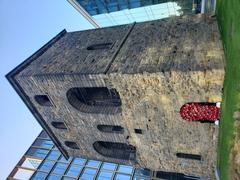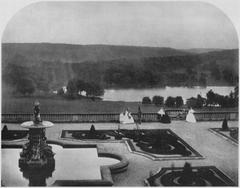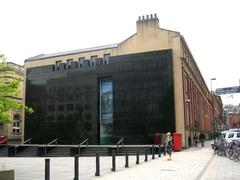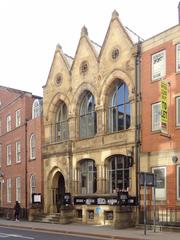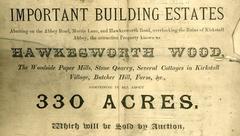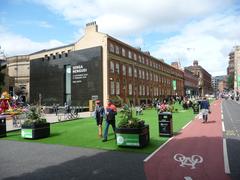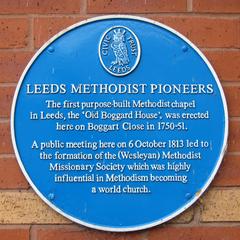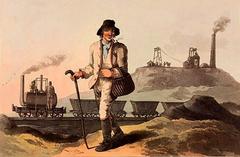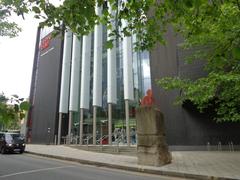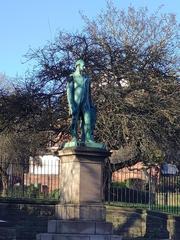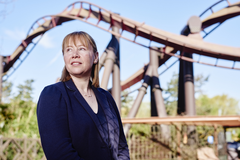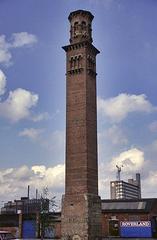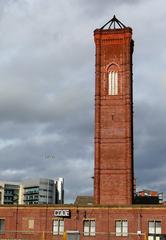Grand Theatre Leeds: Visiting Hours, Tickets, and Historical Sites Guide
Date: 04/07/2025
Introduction
Nestled in the vibrant heart of Leeds, the Grand Theatre is a magnificent emblem of Victorian architectural grandeur and cultural vitality. Since its opening in 1878, this Grade II* listed theatre has been integral to the city’s performing arts scene, celebrated for its stunning Gothic Revival design and history of world-class productions. Designed by George Corson, the theatre reflects Leeds’ ambitious industrial heritage and late 19th-century cultural aspirations, offering a distinctive blend of architectural splendor and artistic excellence (Leeds Heritage Theatres; Arthur Lloyd).
Today, the Grand Theatre is home to Opera North and Northern Ballet, and it regularly hosts touring West End productions, drama, and comedy. Beyond its role as a performance venue, it serves as a vital cultural hub, fostering community engagement, educational outreach, and heritage preservation within Leeds (Leeds Living). This comprehensive guide details everything you need to plan your visit—from opening hours and ticketing to accessibility and nearby attractions—while providing insights into the theatre’s architectural highlights and historical milestones (Leeds Grand Theatre Official Website).
Table of Contents
- Introduction
- Origins and Construction
- Architectural Significance
- Notable Events and Evolution
- Renovations and Modernization
- Practical Information for Visitors
- The Grand Theatre’s Role in Leeds’ Cultural Life
- Frequently Asked Questions (FAQ)
- Visual and Interactive Elements
- Conclusion and Call to Action
Origins and Construction
Officially opened on November 18, 1878, the Grand Theatre was conceived during Leeds’ period of rapid industrial and urban growth. Initiated by local businessmen and civic leaders eager to establish a cultural landmark, the theatre was intended to provide a venue rivaling those in London and other major cities (Leeds Heritage Theatres). Renowned local architect George Corson, with James Robertson Watson’s assistance, drew inspiration from European churches and theatres. The project was completed in just 13 months at a cost of £62,000—a significant investment for the era (Arthur Lloyd).
Architectural Significance
The Grand Theatre is celebrated for its distinctive Victorian Gothic Revival style, setting it apart from contemporaneous theatres that favored classical or baroque motifs. Corson’s design prioritized fireproofing with thick, solid walls and used local millstone grit, a nod to the city’s industrial heritage (leedsyes.com). The auditorium, originally seating about 2,600 people (plus 200 standing), today accommodates around 1,500 for improved comfort and accessibility (Arthur Lloyd).
Inside, the theatre boasts lavish chandeliers, intricate plasterwork, and plush seating, evoking the grandeur of the late 19th century (Freemont Building). The horseshoe-shaped auditorium with tiered boxes was designed to optimize sightlines and acoustics, making it ideal for both drama and opera. A particularly notable feature is the original Victorian scene dock, still in use for scenic painting.
Notable Events and Evolution
The Grand Theatre’s inaugural performance was Shakespeare’s “Much Ado About Nothing.” In its early decades, it hosted a diverse array of productions, from drama and opera to ballet and variety shows. The theatre quickly became a focal point of the city’s social and cultural life, attracting audiences from across Yorkshire (Arthur Lloyd).
Over the years, the stage has welcomed legends such as Henry Irving, Sarah Bernhardt, Laurence Olivier, and Julie Andrews. The theatre’s reputation as a premier venue outside London was cemented by these appearances. In the 20th century, the adjacent Assembly Rooms were converted into the Plaza Cinema (1912), reflecting the rise of film, while the theatre adapted to changing tastes by including pantomimes, musicals, and touring productions.
During WWII and the postwar years, the Grand Theatre remained a vital source of entertainment and community spirit, hosting significant productions like “Idiot’s Delight” (1938) and beloved annual Christmas pantomimes (Arthur Lloyd).
Renovations and Modernization
By the late 20th century, the Grand Theatre required major restoration to meet contemporary standards. From 2005 to 2008, a major refurbishment was undertaken, particularly to benefit Opera North, which had made the theatre its home in 1978. Improvements included new seating, air conditioning, enhanced backstage facilities, and the creation of the Howard Assembly Room as a flexible performance space (Arthur Lloyd). The restoration preserved the building’s architectural features while upgrading its infrastructure for modern audiences, with ongoing projects enhancing accessibility, sustainability, and comfort (Leeds Heritage Theatres).
Practical Information for Visitors
Visiting Hours
- Box Office: Monday–Saturday, 10:00 AM–6:00 PM
- Sunday: 12:00 PM–4:00 PM (check for exceptions)
- Performance Days: Theatre opens one hour before showtime and closes 30 minutes after the performance ends.
- Tours: Check the official website for current tour schedules.
Tickets and Booking
- Where to buy: Official website, by phone (0113 243 0808), or in person at the box office.
- Pricing: Typically £15–£60, depending on the show and seat location.
- Discounts: Available for students, seniors, groups, and early bookings (The Broke Backpacker).
- Membership: Priority booking and exclusive offers through Leeds Heritage Theatres membership (Leeds Heritage Theatres).
Accessibility
- Wheelchair access: Designated accessible seating and step-free entry.
- Facilities: Accessible toilets, hearing loops, and assistance dog accommodations.
- Support: Contact the access line (0113 205 3899) for tailored assistance.
Getting There and Nearby Attractions
- Address: 46 New Briggate, Leeds LS1 6NU
- Transport: 10-minute walk from Leeds railway station; served by multiple city-centre bus routes.
- Parking: Several multi-storey car parks and on-street options nearby, including accessible bays.
- Nearby attractions: City Varieties Music Hall, Leeds Art Gallery, Leeds City Museum, Corn Exchange, Millennium Square (The Tourist Checklist).
Special Events and Tours
- Guided tours: Offered periodically, especially during Heritage Open Days—see official website for details.
- Special events: The theatre hosts concerts, comedy, community events, and educational workshops throughout the year.
The Grand Theatre’s Role in Leeds’ Cultural Life
The Grand Theatre is pivotal to Leeds’ arts scene. As the principal home of Opera North and Northern Ballet, it hosts world-class performances and launches new works (Leeds Heritage Theatres). The theatre is managed by the Leeds Heritage Theatres charity, which also oversees City Varieties Music Hall and Hyde Park Picture House, collectively stewarding over 400 years of local cultural history (Leeds Living).
More than 350,000 visitors attend annually, and the theatre’s educational outreach programs engage over 10,000 young people each year. Its programming is diverse and inclusive, ensuring the arts remain a central part of Leeds’ identity.
Frequently Asked Questions (FAQ)
Q: What are the Grand Theatre Leeds opening hours?
A: Monday to Saturday, 10:00 AM–6:00 PM; Sunday, 12:00 PM–4:00 PM; extended hours on performance days.
Q: How do I buy Grand Theatre Leeds tickets?
A: Purchase online, by phone, or at the box office. Early booking is recommended for popular shows.
Q: Is the Grand Theatre Leeds accessible for wheelchair users?
A: Yes, with step-free access, accessible seating, and facilities.
Q: Are guided tours available?
A: Yes, periodically—check the official website for dates and booking.
Q: What nearby attractions can I visit?
A: City Varieties Music Hall, Leeds Art Gallery, Leeds City Museum, and The Corn Exchange are all nearby.
Visual and Interactive Elements
- Virtual tours: Available on the official website.
- Images: Showcasing Victorian Gothic architecture and the opulent auditorium, with descriptive alt tags such as “Grand Theatre Leeds Victorian Gothic interior” and “Grand Theatre Leeds seating and stage.”
Conclusion and Call to Action
The Grand Theatre Leeds is a striking blend of historical grandeur and contemporary cultural dynamism. Whether you’re attending a performance, joining a guided tour, or exploring nearby attractions, the theatre offers a memorable experience for all visitors. For show schedules, ticket bookings, and the latest updates, visit the official Leeds Heritage Theatres website.
Stay connected: Download the Audiala app for seamless event planning, ticket offers, and exclusive content. Follow Leeds Heritage Theatres on social media and explore related guides to make the most of your visit to Leeds.
Related Articles
Sources
- Leeds Heritage Theatres
- Arthur Lloyd
- Leeds Living
- Leeds Grand Theatre Official Website
- The Tourist Checklist
- Visit Leeds
- Audiala
- leedsyes.com
- Freemont Building
- The Broke Backpacker
- Hand Luggage Only
- Theatres Online
- Leeds Magazine
- The Reviews Hub
- Leeds Theatre
- Explorial
- Kingfisher Visitor Guides
- Yorkshire Post
- Wikipedia: Grand Theatre, Leeds
